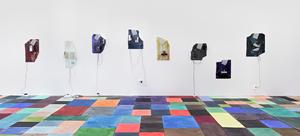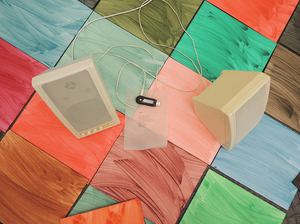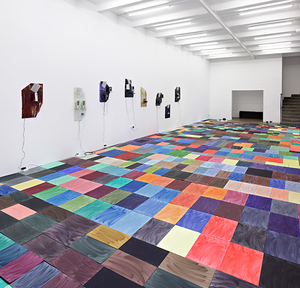Texts: 2013
FRIEZE FOCUS: Painting, poetry and measuring movement
What a mess. When I walked into Natalie Häusler’s solo show Case Mod
at Supportico Lopez, Berlin in January, I expected to find the work I’d
seen on the gallery’s website. The installation shots of monika/subway (floor piece)
(2012) promised a neat grid of cardboard tiles, painted in bright
acrylic colours and covering the gallery’s main floor. By the time I
arrived, the tiles were wildly scattered and marred by dusty footprints.
Häusler had fastidiously positioned them but failed to use glue. The
mingling of guests at the opening had displaced them over the course of
the evening. The most beaten footpath near the entrance bore the brunt
of the destruction while tiles near the walls were untrampled. As an
itinerary, monika/subway started as a grid of happy shades, only to end
up mapping visitor traffic. But it was disturbing to see in one fell
swoop this gradual accumulation of movement, which suggested a disaster
and its victims, say, or the path of a tornado and the stampede of
people escaping. Only then did it occur to me that a twister in
slow-motion might look like a ballet of objects. And that Häusler’s
installation might be about measuring movement, speed, duration – a kind
of action painting in an expanded field.
This field includes not only installations and painting but also poetry,
which – since she fuses all three – allows for the different actions of
exhibiting, writing, reading, recitation and listening. By 2011,
Häusler – who was born in Munich and moved to Berlin in 2012 after two
years in New York (the first on a DAAD grant) – had earned an MFA
from Bard College and a Meisterschüler degree from Braunschweig, both
in painting. The same year, she also co-founded the poetry press AMERICAN BOOKS
with poets Ed Steck and Brett Price. The first publication
Solicitations (2012) – with contributions from 35 artists and writers
– was published last July. The first of Häusler’s poems to appear in her
art – LOSS – LUST
I in her eponymous installation-performance staged at Bard in 2010 –
was printed on foolscap, read aloud by two friends and then scattered
across the installation, like salt on soup. The poem – partly in German,
mostly in English – cites a 1920 letter by Franz Kafka, persuading his
beloved Milena Jesenská that they can see each other better in writing
than through actually meeting. Häusler adds her takes on opacity and
knowledge in the relation between the artist, the work and its viewers:
‘to reveal your process makes you vulnerable’. As her friends read her
poem, Häusler spilled ink on the installation’s fabrics and booklets,
which recalled Rorschach tests and censorship; interpretation and
illegibility. Since then, her poems have appeared in other materials
beyond paper and measure other actions beyond recitation. For Ann (rising) (2012) – an installation for the display windows of Motto bookstore in Berlin – included fragments of her poem BED (2012) printed on champagne glasses, themselves broken into shards. Other installations like A situation of subtle control/ inward-outward gaze (2011) and We are getting a little bit too close here (still life)
(2012) – shown last year at Kunsthalle Ravensburg for the +6|2012
Shortlist Columbus Art Award – feature poems printed on table-like
surfaces. Yet the words look distorted, as if they were floating in
water or reflected in a funhouse mirror. Häusler likes such effects of
movement, perhaps as a textual take on drip painting, and light palettes
that combine colours while keeping them distinct: tiles, screensavers,
watercolours, stained glass. Case Mod featured eight broken
pieces of stained glass hanging in a row on one wall; each piece was
adorned with a poem printed on tracing paper along with an out-dated MP3
player. One could read the poems, like CASINO
in aykan/casino (2013), or listen to them on the earphones – at least
until the batteries died. The show included yet another measure of
duration: the book WATERCOLOURS (2012) traces a year of Häusler’s email correspondence, including illustrations, with fellow artist David Horvitz.
Häusler
– who begins a six-month residency at Paris’s Cité des Arts in May –
may have turned to poetry to avoid using language as elucidation, which
sinks so many of today’s post-conceptual and research-based works. Her
poetic brand of expanded action painting ends up emphasizing, not her
actions, but how viewers may wear down art through interpretation or
even their physical presence. What pilgrims trust they shall encounter (Advanced Morandi Effect / Mere Exposure Effect)
(2012), shown at Supportico Lopez last year, included a table of
drinking glasses, crowded together and brimming with water. As I
approached the work, my footsteps made the glasses tremble, visibly and
audibly. As I moved closer, they chattered like teeth, as if the
prospect of contact were terrifying.
Find the article here:
https://frieze.com/article/natalie-h%C3%A4usler?language=en
Case Mod, Mixed media, Installation view Supportico Lopez, Berlin, 2013 (Courtesy: the artist, Photograph: Hans-Georg Gaul)
Artforum Critics' Picks: Natalie Häusler
Combining sound, painting, text, and sculptural elements, Natalie
Häusler’s latest exhibition, “Case Mod,” blurs the division between
engaging with an artwork sensorially and approaching it cerebrally.
Spreading across the gallery’s floor is a Color Field painting
consisting of cardboard tiles washed in vibrant acrylic paint. Titled
Subway/Monika (floor piece) (all works 2012), the piece evokes the
Emergency Broadcast System image that used to flash across
television screens. Hung on the gallery wall are ten sculptures:
Each is made of broken stained glass and consists of shelves on
which an MP3 player and speakers play sound tracks featuring the
voices of the artist’s friends reciting poetry she has penned herself.
In order to hear each poem, one must lean in—but the edges of
each piece are sharp, acting almost as warnings not to get too
close. The texts of the respective poems are printed on transparent
paper and draped over the top of each shelf,
softening the boundaries
of the shelves and almost turning them into works of concrete poetry.
The title of the show comes from case modification, the practice of altering
the chassis of a computer hard drive in
an attempt to show off some special
or unique feature. While the only thing being modified in the gallery is the
floor,
and then only nonpermanently, the works in this exhibition activate
the viewer’s capacity to transform a complex of
sound, text, and art into his
or her own artistically enjoyable experience.
SUPPORTICO LOPEZ
Kurfürstenstrasse 14/b
January 11–February 16
All rights reserved. artforum.com is a registered trademark of Artforum
International Magazine, New York, NY
Natalie Häusler, Case Mod
Case Mod
Natalie Häusler’s installation Case Mod
(from: Case Modification) exacts from the gallery space a field in which
intimate and reciprocal encounters between audience and art practice
are put to the test. Häusler compiles a situation, combining several
elements derived from a simultaneity of studio and writing practice.
Emerging forms, in this case, watercolor, sculpture and poetry, query
whether they can uphold their fragilities and force of expression when
exposed to the viewer and to each other. They articulate their mutuality
when arranged in the exhibition space, producing crosscuts and
intimacies, of visual, written and audio material, as well as of object
and spectator / reader / listener. The audience becomes belated witness of
the art practice as such, which the installation at once showcases and
archives. Yet the present moment is highlighted, as the visitors leave
their own marks on the piece, subtly shifting the color palette or
destroying it altogether. Audio recordings of the voices of close
friends, who are practicing artists and writers, reciting the poems,
track down their intimate reception by an audience that is involved in
both activities, production and reception. They capture the moment of
surprise, when the poem was read for the first time. The intimacy of
this contact is shared with the passing visitor, who must come close to
the audio shelf, to be able to hear the individual reading. These
shelves, each of which is cut and built from one sheet of stained glass,
and customized for its assigned set of outmoded electronic equipment,
serve as seductive support and hazardous repellant at the same time. The
temporary construction of a space of this kind is part of Häusler’s
inquiry of forms of intimacy, risk, close contact with the material, and
inclusion to question modes of reception.
____
plums and fruit and knife
and knives and knife
and plum and bite
and fruit and juice
and cut and bite
and flesh and plum
and plum and plums
and cut and flesh and juice
Language, or “knife”, if we follow the poem, can break the rules a poem has set up for itself. Here, “knife” cuts the semantic chain that fruit and plum, as a whole-part lexical relation, establishes, and therefore makes the poem change course. We ask whether such clean incisions into an artwork’s inner logic can be achieved in visual practice as well. Natalie Häusler’s installation Case Mod (i.e. from: Case Modification) attempts to master the art of incision that poetic language seems to achieve with such elegance and directness. Language, bound by the laws of signification, allows for such sudden moves that can cause a drastic re-shuffling of the poem’s continued logic and imagery. Yet whereas “knife” can terrorize and hijack the lines of the poem, the knife-drawing on silk remains in direct and three-dimensional contact with its neighbors, the other artworks. It
hovers above and among them as a large exclamation mark or downward thrust, but its support, silk that remains fluid and in motion, is emblematic of "knife's" continuity with a constructed and to a large extent fixed environment that moves forward in time on a single spatial axis. “Knife” within the installation also cuts open the installation and attempts a rupture, but the installation will not yield and abandon the other things it has gathered and brought together. It is the poem itself that gives us a taste for such continuing oscillation and movement in the image of “juice”, palette fluid matter that erupts from the cut object, spilling the poem and rendering its borders fluid. Similarly, Häusler constructs a floor from monochrome paintings on cardboard that ask for something to be spilled on their already water-based, painted surface, to wash its colors, shift the palette, soak and dissolve it.
As parallel to the poem’s stark shifts of image registers, the shifts in the installation take place on the fluid surfaces of painting, which cause more finely tuned ruptures. The color mosaics, installed on the gallery floor, are painted in monochrome, warm hues, but are also configured as a structural grid. By that Häusler emphasizes the possibilities for variation and non-permanence of the grids that serve both as painting and architectural support.
Wall shelves built from tinted glass echo the monochrome palette of the floor painting, but also serve as structural support for the exhibition of Häusler’s poems, both in audio and print format. They break the sound waves that emanate from the audio speakers they carry, and become catalysts for the dispersal of Häusler’s poem’s in the exhibition space. The poems are read out loud by close friends, who are practicing artist and writers. They track down a moment of intimate reception by these readers who are involved in both the production and reception of the poem. The intimacy of this contact is shared with the passing visitor, who must come close to the audio shelf to be able to hear the individual poem. These shelves, each cut and built from one sheet of stained glass, each customized for its assigned set of outmoded electronic equipment, serve as seductive support and hazardous repellant at the same time.
Thus, the combined material oscillates between structural grid, and the contingencies and intimacies of painterly and poetic practice. The visitor finds her or himself in between those dynamic poles. Thus the installation both draws, even coerces the visitor into co-creating its surfaces, yet inserts antagonistic lines and breakages into those spaces of intimacy. The temporary construction of a space of this kind is part of Häusler’s inquiry into forms of intimacy, risk, close contact with the material, and inclusion as forms of reception.
Natalie Häusler’s installation Case Mod exacts from the gallery space a field in which she puts intimate and reciprocal encounters between audience and art practice to the test. Her work interrogates the installation space as a space of social and political relevance, not by making statements via an argumentative dialectics, but through observation, commentary and systematic disruption, for which the inclusion of her poetry serves as focal point. Her commentary emanates from and necessarily includes the subjective, which she insists must remain visible in her work. Häusler generates systems and constructions that colonize the exhibition space in an exacting fashion, yet builds into these exhaustive structures parts that will disintegrate, that can spill and are fluid. Her poems, and language as such, remain part of the installation as points of contraction and literacy. They activate the gallery space as literate, social, and by extension political space. The convergence of poetic and visual practice is never hierarchical nor does one cancel out or override the other. Rather, the act of exhibiting her poems activates their potential for a formal as well as critical multi-dimensionality and both practices enter into a binding contract, which demands of these forms to remain accountable, to each other as well as to the viewer.
The book “Watercolors” documenting a one and a half year long correspondence in form of watercolors sent via email between Natalie Häusler and Californian artist David Horvitz is part of the exhibition. A book launch will be held on January 12th at Motto Berlin.
__
Case Mod
11 January – 16 February 2013
Supportico Lopez, Berlin

















